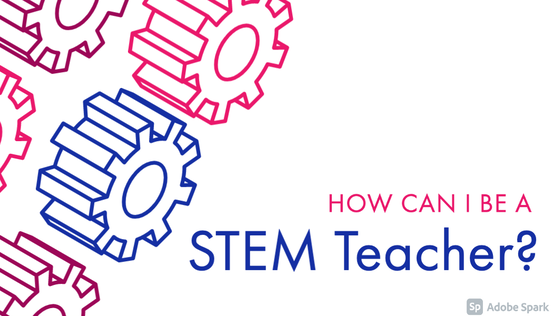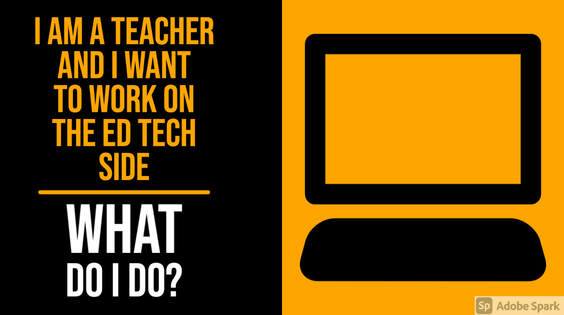|
What does STEM actually mean? There are so many acronyms now for it: STEM, STEAM, STREAM. I am sure I am missing something. In the end, you can almost put any content or subject areas under one of them. So, the question then becomes, “How can I be a STEM teacher?” The rub is that anyone can actually be one, and it’s not incredibly hard.
Obviously, being a STEM teacher in Math, Science, and Technology is easy. It’s the nature of what you do, but if you are just trying to have students regurgitate facts, are you a STEM teacher? I think the short answer is no. You aren’t exploring, so you are losing the intent of STEM. To simplify what STEM is, think of it in the realm of exploration and creation. Naturally, that’s what the STEM design process is. You are researching, asking questions, and coming to conclusions. You can do this in any class. It could be in the form of a lab, experiment, research, or, more importantly, a creation process. It means that if you are creating in your classroom, you can easily be a STEM teacher. When you make, it’s actually the process that matters, and the STEM design process works perfectly in any class. You can apply the steps of brainstorming, researching, and much more to build stories, even in Social Studies and ELA. Yes, you read that right. Social Studies and ELA teachers can be STEM teachers. In the end, education acronyms are silly. STEM is no different. It’s doing something that we should all be doing anyway and putting a new focus on it. Making and creating gives students a deeper understanding, it can be done in any classroom, and the process can be the STEM design process. Really, if you are making and creating, you are a STEM teacher. It’s just putting a new spin on it.
0 Comments
Do you know what brings meaning to student creation? Having great scenarios for students to create with, Think about all the student projects you have seen. What is one of the common denominators for the bad ones? It is usually that they are just about a specific topic. There is little deeper learning there, and those are easy to copy from Wikipedia. What if we turned that activity on its head and made students be a person or concept. They would have a different understanding because they have to get into that personal headspace. It’s no longer a regurgitation of fact.
By putting students in the mindset of a historical character, literary character, or in some type of concept, they get a deeper understanding of who that person was and their intentions. The best thing about it is there are some great and easy ways to do it. They include:
I get asked a decent bit by teachers what it is like to work at an ed-tech startup and how I can make that transition. With nearing three years under my belly at Tynker, I figured it was a great time to give some advice and tips about what life is like and how to move into a position like mine. It’s an intense environment, but it’s one I have grown to love.
I think the first thing to look for is to find the right company. Obviously, many people want to work for Apple, Google, and Microsoft, making those positions hard to get. While there are great benefits working at one of the big guys and more power to you if you can get those positions, I simply prefer for the moment to work for a company where I can experience exponential growth, and I can make more of an impact in what I do. I came to Tynker first and foremost because I believed in the mission. I saw one member of the education team at Google speak a few years ago, and he said something to the effect of, “ not everyone needs to be a programmer, but everyone will need to understand how code works.” To me, that put it perfectly, why I am at Tynker. With the way the world is moving, we need to give every kid the opportunity to code, and I think Tynker is the best place to do that. You won’t find any other site that is easier for teachers to use, has core curriculum lessons to code in any class, and goes all the way K-12. To me, that’s magic I can work with. The second thing to look for is the proper position. The tricky thing is that actual teaching and PD positions in the field are somewhat limited. No matter where you are (big or small), revenue is going to come first. That means the more accessible positions to grab usually are sales roles, and you may have to start there to get your foot in the door. I did. I wasn’t great at it, but I would not be where I am without taking that risk. Selling is an art, and if you are a people person, you may make that transition well. I am, unfortunately, a bit awkward in initial one on one interactions. I am not super comfortable just going up to a person and introducing myself. I am fine in front of big groups and fine when someone comes to me first, but I don’t do super well initiating. That was my downfall in sales, but what I did do was show enough initiative, smarts, and ideas on education that they kept me around. From there, my role grew with hard work, and if you chose the right company, you could have similar circumstances. Of course, you could also be successful in sales (I have a friend who made that transition.) The third thing to know going in is that this job and way of life is not for everyone. Startups are intense, and at times can be stressful. The biggest reasons companies grow their workforce is to continue that division of labor as you grow your customer base. That means that when you’re small, it can be challenging, and you do many different tasks. For me, that’s great. I love that my hand is in so many pots, and I can directly see my influence on things. The workload and intensity don’t bother me (although there have been times I have had to grow into.). If you like being comfortable, though, it may not be for you. It’s something to do some soul searching on before you take a position. If you are thinking about making the transition, the rewards can be huge. It just takes buckling down and doing the work to get there. I love what I do as I get to affect teachers and students worldwide and affect a [product I truly believe in. If you feel like you can get to that place, it’s definitely worth the jump. If you still have questions, you can always email me at [email protected]. Politics are back meddling in what goes on in the classroom. You see it from how politicians address funding in the pandemic to teaching civil rights movements in schools. Some of it can be positive, but shifting education thinking and ideals based on political headwinds can also be hazardous. It weakens the academic product.
The American education system has always had the problem of being intertwined in political conversations, but there may not be an excellent way to break away from it. With schools publicly funded, they have to do what members of Congress and other government entities require to get those funds. Sometimes that could be as easy as showing some sort of struggle (like in the pandemic). Other times, it could be meeting some tough to reach goal. Whatever it may be, it brings a new level of scrutiny to a group of people who should be focusing on students first. Schools are supposed to be funded almost wholly through property taxes, but that funding system is broken. Many areas of the country have changed their tax laws to a point where the funding levels just aren’t there, and other schools reside in areas where the property values are so low that they never will be. You have also seen school budgets ballon for various reasons to keep up with the demands and needs of students. There just isn’t enough natural funding flowing in, and it means that politicians can set arbitrary requirements to get what’s needed to supplement. You are seeing this play out right now with theories focused on race and civil rights movements. Political thought tends to focus on making students patriots and believing that the United States is the most excellent place globally. While at a younger level, that’s incredibly valid, as students get older, it misses the point of what studying history should be. The history of the country is messy. The US is not perfect. People have been oppressed throughout US history, but what makes the US great is adapting and overcoming. Things still aren’t perfect, but I think we will continue that adaptation and overcoming. The thing about it is, though, if we don’t study past mistakes, how can we? It’s not to say there aren’t extreme cases of theory and thought that have edged their way into schools. There is a thin line there. Politically though, we live in a time of absolutes. With politics involved, we will severely limit the lessons we can learn from the different perspectives that come from historical theories. We will limit the way we adapt and overcome. To limit radical ideas in schools, I think there are better ways we can approach things. The first thing is that we have to teach theory as theory, and we need to limit the age range it goes to. There is nothing wrong with teaching theories and different perspectives to students that can think critically. They get to see a different perspective on the world, and they can decide with some academic skill how much of that theory applies to both themselves and their views of others. We also need to have academics set content rather than politicians and have politicians be ok with that. Yes, academics will disagree, but they are much less likely to change content requirements than politicians. We can’t bounce what kids learn based on who is in power. The only way any of this will take is to change the way we do school boards. More often than not, these are members of the community who have had no experience in schools. They are, at their nature, junior or failed politicians. They should have to have experience in education. With that, they could have a unified voice to oppose extreme education bills in state legislatures and the US Congress, and for goodness sake, they for sure do not be aligned with any political party. |
Archives
January 2023
Categories |




 RSS Feed
RSS Feed
